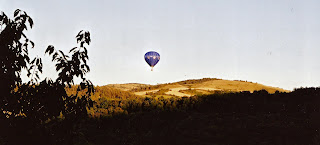

The first time I thought of reflections in water as a subject for painting in their own right, rather than as an incidental element in a landscape, was in 2006-7, when I painted "Geometry of Reeds." I had taken a couple of photographs at Emma Lake in Saskatchewan (please see my blog post of February 7, 2011, for more details of this trip), but had been surprised by the results: I had intended neither to take such a close-up view of the reeds, nor to take the picture in black and white. I never found out how I had managed to take these photos, but I liked the way each reed and its reflection made an arc, and the way the two halves of the composition were almost, but not entirely, symmetric. In the painting I added non-realistic colours from imagination, but otherwise kept close to my mysterious photographs.
 |
| Geometry of Reeds - acrylic - 40" x 30" - 2006 |
I sold the painting at the Eastside Culture Crawl in 2007. It was the first time that a potential client had seen a painting of mine on the Internet, and had come in specially to find it. The client liked the real thing, and wanted to buy it, but since it was quite large (40" x 30") she felt she needed to go home and measure her wall before committing herself. I agreed to hold the painting until she came back. When she did she was clearly quite upset. While she was talking to me the first time, someone had broken into her car and vandalized the door handle so the door wouldn't close. She had nevertheless gone home, done her measuring, and returned to complete the purchase--leaving an unlockable car in the same parking lot! I felt that her determination and enthusiasm for my work was as big a compliment as the deal itself.
It wasn't until 2010 that I returned to the study of reflections. I had suggested the subject to the Vancouver Sketch Club as a possible theme for a Club exhibition. My fellow members took up the challenge with enthusiasm, and I produced three small paintings myself, while collecting ideas for larger ones.
 |
| Bridge on the Lydd - acrylic - 11" x 14" - 2010 |
"Bridge on the Lydd" was painted on site during a painting holiday at Brambles on the borders of Devon and Cornwall in Southwest England. Artist hosts Janet and Peter offer short courses, workshops and art retreats in and around their old converted farm property (to view see
www.bramblesartretreat.com ) where in June 2010 the glorious summer weather allowed us to paint outdoors every day. Even so, we got a bit chilly working in the partly dried up river bed, and the high spot of the day came when Peter left us for a while to bring us hot Cornish pasties from the nearest pub.
 |
Fishes in Circles - 8" x 8" - 2010
|
"Fishes in Circles" and "Public Baths" were painted with the Sketch Club show in mind, but more immediately for the Anonymous Show which is mounted each November by North Vancouver Community Arts Council. It's a fund-raising event for the Council, with each painting being priced at $100, of which the artist keeps half in the event of a sale. The paintings all have to be eight inches square, and are displayed anonymously, which is supposed to entice buyers to gamble on acquiring, for a very modest price, something which
may have been painted by someone famous! Gallery walls covered with the tile-like paintings make for a very attractive display, and this is a painless way to collect original paintings, whether or not they are a sound financial investment.
www.nvartscouncil.ca/exhibitions/anonymous-art-show-2010
 |
| Public Baths - acrylic - 8" x 8" - 2010 |
The window of my studio space overlooks the roofs of the buildings across the street, and I enjoy watching the birds--mostly seagulls and pigeons--that congregate there, especially when the rain has left big shallow puddles. The pigeons in "Public Baths" reminded me of ladies at a beauty salon as they offered each other preening advice and admired themselves in the mirror. No one snapped up this small painting in the Anonymous Show, but it did sell in the summer at the Sketch Club show at the West End Community Centre.
 |
| The Picnic - acrylic - 24" x 20" - 2011 |
And so to 2011. One of my first paintings this year was "The Picnic"-- my only attempt so far to paint human beings reflected in water. It's based on a photo taken on one of my trips. I have no idea who the people are, and I don't think they would recognize themselves from this portrayal. Perhaps it's better that way, as I'm not sure they were enjoying their day out very much. As with other paintings of people, I was interested in the body language of the subjects. In this case, there seems to be little connection or communication between the man and his wife, who are each lost in their own thoughts.
Next blog post mid-October


















































